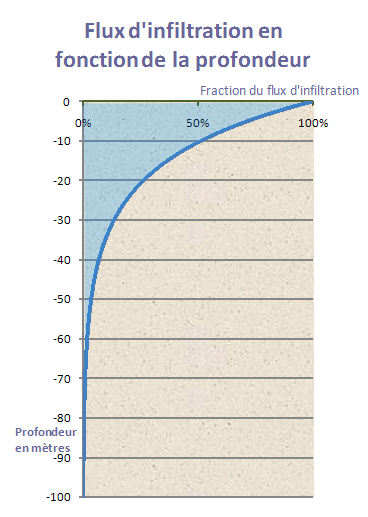Where does the water go which infiltrates in the ground?
All the water which penetrates in the ground by infiltration does not arise on the surface, typically because part of this flow of infiltration goes down under the undulations of the ground low. As this flow does not go down indefinitely and that all the grounds are not gorged with water, a balance must necessarily settle between underground water flow going down and an ascending underground water flow. This ascending flow constitutes the field of study of the angiogeology. It starts in the geothermal reservoirs.
This question, puerile seemingly, is far from calling a commonplace answer. It is however essential to be posed it to understand the crucial role - and too often neglected - ascending underground water flow conveyed by the water vessels.
The water which returns in the ground, must also leave there
Initially two obvious facts:
- the flow of infiltration continues year by year and varies little on an annual base,
- the flow of infiltration decreases with the depth. Beyond a few tens of meters deep, the flow of infiltration is not any more but of some pourcents of than it is on the surface (according to the permeability of the crossed geological layers). It is obviously an order of magnitude, not a universal law of hydrogeology. This infiltration decreases in a qualitatively comparable proportion with the restricted parking zone represented on the diagram below. The water which enters the ground thus does not leave there completely by bottom, but then, by where.

On sufficiently long periods of time, all the water which penetrates in the ground must come out from it. This report raises the question of how. To Follow the wire of this reflection until the pleasing end to understand the crucial role played by underground water flows ascending which result - directly or indirectly - geothermal reservoirs.
Theoretical Evolution of the flow of infiltration with the depth
Underground water flows
The figure below synthesizes underground water flows compared to the directions of space:

Underground water flows are composed of one:
- flow of infiltration downward, Φi
- the vertical gradient of this flow of infiltration, ∇Φziis negative (what does not translate of other than the fact that flow decreases with the depth, as shown on the figure above)
- the average of the horizontal gradients of this flow, ∇Φxiand ∇Φyiis worthless under the level low of the relief.
- ascending flow, Φa, coming directly or indirectly from a geothermal reservoir
As the flow of infiltration under the undulations of the ground low decreases with the depth and that its horizontal gradient is - on average - no one, the water which infiltrates under this level:
- impregnate the ground until saturation; this one is gorged with water and its surface becomes a marsh; the steady state mode is reached when the water feedings via surface are compensated by an evaporation and/or a streaming of surface water,
- or the water which infiltrates evacuates without completely soaking the ground, flows of water which enter the ground and those which leave there balance (at the level of time which interests us).
Underground water flows according to the directions of space
With regard to percolation water above undulations of the ground low, the traditional explanation - - and academic - is partially correct. A diagram of the type of this one synthesizes this explanation:

The water which infiltrates in the ground crosses the permeable layers until…
it meets an impervious layer on which it runs out until…
to find a discharge system with the free air or it forms a source.
Theoretical and idealized Sight evacuation in water surface of infiltration
It is true for the grounds presenting a strong declivity (like that represented on the illustration above).
But… all the grounds do not present such a declivity.
Which discharge system for “too low” water
Why all the grounds of plain aren't gorged with water at the point to present itself as marshes (what they should be since time that they receive the water of precipitations which they cannot evacuate)?
Where share the water which infiltrates in the plains or the subsoils located under the lower level of the undulations of the ground low?
- it cannot reach surface without going up since it is located at a level lower than that of the points of surface low,
- the increase by capillarity (negligible) do not compensate for the infiltrations by gravity,
- the plants cannot capture the water of the ground lower than their roots to recycle it by evapotranspiration.
- it is not inserted to the entrails of the ground since its flow of infiltration strongly decrease with the depth,
- it does not move massively in a horizontal plane.
Recycling on the surface of the flow of infiltration
The flow of infiltration which goes down under the undulations of the ground low arrives, despite everything, to go up on the surface thanks to ascending underground water flow. This One is presented in 3D. This ascending underground water flow, conveyed by the water vessels, is very localised while the flow of infiltration is diffuse. The flow of infiltration is collected in the many aquifers close to surface (typically with a depth lower than 100 meters). These aquifers are located at various depths and cover practically all surface (seen ground). The water vessels which flow in these aquifers make go up on the surface the percolation water which is collected there, thanks to overpressures which they induce in these sheets. The gradient hydraulic of these water vessels - very high and very localised - compensates for the gradient - negligible, but distributed on all surface - flow of infiltration.
The geothermal reservoirs constitute the starter of this ascending underground water flow.
